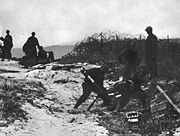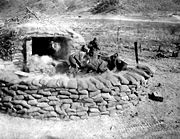
M2 4.2 inch mortar
Encyclopedia


Mortar (weapon)
A mortar is an indirect fire weapon that fires explosive projectiles known as bombs at low velocities, short ranges, and high-arcing ballistic trajectories. It is typically muzzle-loading and has a barrel length less than 15 times its caliber....
used during the Second World War and the Korean War
Korean War
The Korean War was a conventional war between South Korea, supported by the United Nations, and North Korea, supported by the People's Republic of China , with military material aid from the Soviet Union...
. It entered service in 1943.
History
The first 4.2-inch mortar in U.S. service was introduced in 1928 and was designated the M1. Development began in 1924 from the British 4-inch (102 mm) Mk I smooth-bore mortar. The addition of rifling increased the caliber to 4.2-inch. The M1 fired chemical shells to a range of 2,195 meters. Upon the entry of the United States into World War IIWorld War II
World War II, or the Second World War , was a global conflict lasting from 1939 to 1945, involving most of the world's nations—including all of the great powers—eventually forming two opposing military alliances: the Allies and the Axis...
, the U.S. Army
United States Army
The United States Army is the main branch of the United States Armed Forces responsible for land-based military operations. It is the largest and oldest established branch of the U.S. military, and is one of seven U.S. uniformed services...
decided to develop a high explosive round for the mortar so that it could be used in a fragmentation role against enemy personnel. In order to extend the range to 2,926 meters, more propellant charge was used and parts of the mortar were strengthened. Eventually, the range of the mortar was extended to 4,023 meters. The modified mortar was designated the M2. The M2 was first used in the Sicilian Campaign
Allied invasion of Sicily
The Allied invasion of Sicily, codenamed Operation Husky, was a major World War II campaign, in which the Allies took Sicily from the Axis . It was a large scale amphibious and airborne operation, followed by six weeks of land combat. It launched the Italian Campaign.Husky began on the night of...
, where some 35,000 rounds of ammunition were fired from the new weapon. Subsequently, the mortar proved to be an especially useful weapon in areas of rough terrain such as mountains and jungle, into which artillery pieces could not be moved. The M2 was gradually replaced in U.S. service from 1951 by the M30 mortar.
Starting in December 1942, the US Army experimented with self-propelled 4.2-inch mortar carriers. Two pilots vehicles based on the M3A1 halftrack
M3 Half-track
The Carrier, Personnel Half-track M3 was an armored vehicle used by the United States, the British Empire and the other Allies during World War II and the Cold War. Nearly 43,000 were produced, and supplied to the U.S...
were built, designated 4.2 inch Mortar Carriers T21 and T21E1. The program was cancelled in 1945.
Tactical organization
4.2-inch mortars were employed by Chemical mortar battalionChemical mortar battalion
The United States chemical mortar battalions were army units attached to U.S. Infantry divisions, and it was their responsibility to service the 4.2 in chemical mortar during World War II. For this reason they were also called the "Four-deucers"....
s. Each battalion was authorized forty-eight M2 4.2-inch mortars. In World War II, an infantry division was often supported by one or two chemical mortar companies with twelve mortars each. In the Korean War, an organic company of twelve 4.2-Inch mortars supported each infantry regiment
Regiment
A regiment is a major tactical military unit, composed of variable numbers of batteries, squadrons or battalions, commanded by a colonel or lieutenant colonel...
.
Ammunition
The mortar's M3 high explosive (HE) shell packed 3.64 kilograms of explosive charge, placing it between the M1 105-mm HE shell (2.18 kilograms of charge) and M102 155-mm HE shell (6.88 kilograms of charge) in terms of blast effect. The mortar could also fire white phosphorus-based smoke shells and mustard gas shells. Chemical weapons were not used in these wars and the U.S. ended up with a large number of these shells, declaring over 450,000 of them in stockpile in 1997 when the Chemical Weapons Treaty came into force. Destruction efforts to eliminate this stockpile are continuing with a few of these aged shells occasionally found to be leaking.| Available ammunition | |||||
| Type | Model | Weight, kg | Filler | Muzzle velocity, m/s | Range, m |
| HE-T | HE M3 Shell | 11.11 | TNT, 3.64 kg | 256 | 4,023 |
| Smoke | WP M2 Shell | 11.57 | White phosphorus (WP) | 250 | 3,932 |
| Chemical | H M2 Shell | 13.00 | HD Sulfur mustard The sulfur mustards, or sulphur mustards, commonly known as mustard gas, are a class of related cytotoxic, vesicant chemical warfare agents with the ability to form large blisters on exposed skin. Pure sulfur mustards are colorless, viscous liquids at room temperature... , 2.7 kg, or HT Sulfur mustard The sulfur mustards, or sulphur mustards, commonly known as mustard gas, are a class of related cytotoxic, vesicant chemical warfare agents with the ability to form large blisters on exposed skin. Pure sulfur mustards are colorless, viscous liquids at room temperature... , 2.6 kg |
256 | 4,460 |
Use by other nations
The M2 was exported by the U.S. to other nations. As of 1984, nations using the M2 included AustriaAustria
Austria , officially the Republic of Austria , is a landlocked country of roughly 8.4 million people in Central Europe. It is bordered by the Czech Republic and Germany to the north, Slovakia and Hungary to the east, Slovenia and Italy to the south, and Switzerland and Liechtenstein to the...
, Bolivia
Bolivia
Bolivia officially known as Plurinational State of Bolivia , is a landlocked country in central South America. It is the poorest country in South America...
, Brazil
Brazil
Brazil , officially the Federative Republic of Brazil , is the largest country in South America. It is the world's fifth largest country, both by geographical area and by population with over 192 million people...
, Cambodia
Cambodia
Cambodia , officially known as the Kingdom of Cambodia, is a country located in the southern portion of the Indochina Peninsula in Southeast Asia...
, Colombia
Colombia
Colombia, officially the Republic of Colombia , is a unitary constitutional republic comprising thirty-two departments. The country is located in northwestern South America, bordered to the east by Venezuela and Brazil; to the south by Ecuador and Peru; to the north by the Caribbean Sea; to the...
, Ethiopia
Ethiopia
Ethiopia , officially known as the Federal Democratic Republic of Ethiopia, is a country located in the Horn of Africa. It is the second-most populous nation in Africa, with over 82 million inhabitants, and the tenth-largest by area, occupying 1,100,000 km2...
, Greece
Greece
Greece , officially the Hellenic Republic , and historically Hellas or the Republic of Greece in English, is a country in southeastern Europe....
, Guatemala
Guatemala
Guatemala is a country in Central America bordered by Mexico to the north and west, the Pacific Ocean to the southwest, Belize to the northeast, the Caribbean to the east, and Honduras and El Salvador to the southeast...
, Japan
Japan
Japan is an island nation in East Asia. Located in the Pacific Ocean, it lies to the east of the Sea of Japan, China, North Korea, South Korea and Russia, stretching from the Sea of Okhotsk in the north to the East China Sea and Taiwan in the south...
(Japan Ground Self-Defense Force), Laos
Laos
Laos Lao: ສາທາລະນະລັດ ປະຊາທິປະໄຕ ປະຊາຊົນລາວ Sathalanalat Paxathipatai Paxaxon Lao, officially the Lao People's Democratic Republic, is a landlocked country in Southeast Asia, bordered by Burma and China to the northwest, Vietnam to the east, Cambodia to the south and Thailand to the west...
, Tunisia
Tunisia
Tunisia , officially the Tunisian RepublicThe long name of Tunisia in other languages used in the country is: , is the northernmost country in Africa. It is a Maghreb country and is bordered by Algeria to the west, Libya to the southeast, and the Mediterranean Sea to the north and east. Its area...
, and Paraguay
Paraguay
Paraguay , officially the Republic of Paraguay , is a landlocked country in South America. It is bordered by Argentina to the south and southwest, Brazil to the east and northeast, and Bolivia to the northwest. Paraguay lies on both banks of the Paraguay River, which runs through the center of the...
.
See also
- Chemical mortar battalionChemical mortar battalionThe United States chemical mortar battalions were army units attached to U.S. Infantry divisions, and it was their responsibility to service the 4.2 in chemical mortar during World War II. For this reason they were also called the "Four-deucers"....
- Mortar (weapon)Mortar (weapon)A mortar is an indirect fire weapon that fires explosive projectiles known as bombs at low velocities, short ranges, and high-arcing ballistic trajectories. It is typically muzzle-loading and has a barrel length less than 15 times its caliber....
- Ordnance ML 4.2 inch MortarOrdnance ML 4.2 inch MortarThe Ordnance ML 4.2 inch Mortar was a heavy mortar used by the British and other armies.-History:The SB 4.2 inch mortar British entered service in 1942 to equip chemical warfare companies of the Royal Engineers. The Mark 3 became the standard model. The mortar was a Smooth Bore design...
– British mortar. - 107mm M1938 mortar107mm M1938 mortarThe Soviet 107mm M1938 mortar was a scaled-down version of the 120mm M1938 mortar intended for use by mountain troops and light enough to be towed by animals on a trolley....
– Soviet mortar.
External links
- Popular Science, April 1940, Army's Smoke Throwers early detailed article on 4.2 mortar

